Lyons W.C. (ed.). Standard handbook of petroleum and natural gas engineering.2001- Volume 1
Подождите немного. Документ загружается.


Well Cementing
1195
Table
4-160
Water Requirement
of
Cementing Materials
Material
API Class
A
and
8
cements
API Class C cement
API Class
0
and
E
cements
API Class
G
cement
API Class H cement
Chem Comp cement
Ciment Fondu
Lumnite cement
HLC
Trinity LiteWate cement
Activated charcoal
Barite
Bentonile
(gel)
Calcium chloride
Gypsum hemihydrale
Diacel
A
Dmcel
D
Diacel LWL
(Hi
Early)
(retarded)
CFR-
I
CFR-2
Gilsonite
HALAD
-9
HALAD.
-
14
Hematite
HR-4
HA-7
HR-12
HR-20
Hydrated lime
Hydromite
LA-2
Latex
LAP.1 powdered latex
Perlite regular
Perlite Six
Pozmix
A
Salt (NaCI)
Sand. Ottawa
Silca
lbur (SSA-1)
Coarse sllia (!3!%-2)
Tuf Addilive
No.
1
Tuf Plua
NF-P
Water Requirements
5.2
gal
(0.70 cu A)/94-lbm sack
6
3
gal
(0.84
cu n)/94-lbm sack
4
3
gal
(0.58
cu lW94-lbm sack
5.0
gal (0.67 cu ft)/94-lbm sack
4
3
10
5
2
gaW-lbm sack
6
3
gal
(0.84
cu f1)/94-lbm sack
4.5
gal
(0.60
cu fl)M4-lbm sack
4.5
gal
(0.60
cu fl)/94-lbm sack
7.7
to 10.9 gaU87-lbm sack
7.7 gal (1.03 cu ftfl5-lbm sack
none at 1 lbmlsack
of
cement
2.4
gal
(0.32
cu nyloo-lbm sack
1.3
gal (0.174 cu
ft)/2%
in cement
none
4.8 gal
(0.64
cu fI)/lOO-lbm sack
none
none
none
3 3
Io
7.2 galllO%
in
cement
(see
LI
Wt. Cement)
none (up
to
0.7%)
0.8 to
1
.O
gaVl%
in
cement
(except
get
or Diacet
D
slurries)
2.0
gal
(0.267 cu
ft)/sO
Ibm/cu
ft
none
(up
to
0.5%)
0.4
to
0.5
gallsack
of
cement at over
none
0.36
gal
(0.048
cu ft)/lOO-lbrn sack
none
none
none
none
0.153
gal
(0.020 cu hplbm
3.0
gal
(0.40
cu fl)/ioo-lbm sack
0
to
0.6
gallsack
01
cement
1.7
gal
(0.227 cu fI)/l% in cement
none
4
0
gal
(0.535
cu
hy8
IbnWcu
ft
6.0
gal
(0.80
cu
fIy38
lbmlcu
h
3.6
gal
(0.48 cu ftn4 lbmlcu
11
none
none
1.5
gal
(0.20 cu
ftpS%
in cement
none
none
none
(maximum)
0.5%
(32.9 Ibm)
-
Source: Courtesy Halliburton Services
Diatomaceous Earth. Diatomaceous earth has a lower specific gravity than
bentonite. Like bentonite this additive also requires additional water to be added
to
the slurry. This additive will affect the slurry properties similar to the addition
of bentonite. However,
it
will not increase the viscosity as bentonite
will
do.
Diatomaceous earth concentrations as high as
40%
by weight of cement have
been used. This additive is more expensive than bentonite.
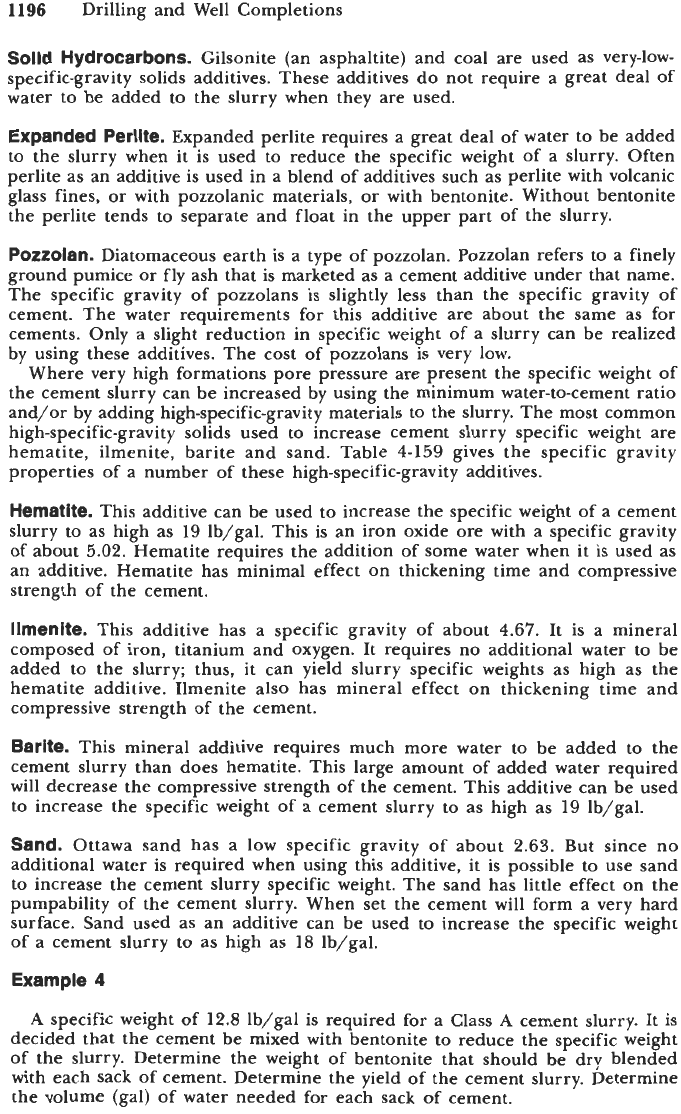
1196
Drilling and Well Completions
Solid Hydrocarbons.
Gilsonite (an asphaltite) and coal are used as very-low-
specific-gravity solids additives. These additives do not require a great deal of
water to be added to the slurry when they are used.
Expanded Perlite.
Expanded perlite requires a great deal of water to be added
to the slurry when it is used to reduce the specific weight of a slurry. Often
perlite as an additive is used in a blend of additives such as perlite with volcanic
glass fines, or with pozzolanic materials, or with bentonite. Without bentonite
the perlite tends to separate and float in the upper part of the slurry.
Pozzolan.
Diatomaceous earth is a type of pozzolan. Pozzolan refers to a finely
ground pumice or fly ash that is marketed as a cement additive under that name.
The specific gravity
of
pozzolans is slightly less than the specific gravity of
cement. The water requirements for this additive are about the same as for
cements. Only a slight reduction in specific weight
of
a
slurry can be realized
by using these additives. The cost of pozzolans is very low.
Where very high formations pore pressure are present the specific weight of
the cement slurry can be increased by using the minimum water-to-cement ratio
and/or by adding high-specific-gravity materials to the slurry. The most common
high-specific-gravity solids used to increase cement slurry specific weight are
hematite, ilmenite, barite and sand. Table
4-159
gives the specific gravity
properties of a number of these high-specific-gravity additives.
Hematite.
This additive can be used to increase the specific weight of a cement
slurry to as high as
19
lb/gal. This is an iron oxide ore with a specific gravity
of about
5.02.
Hematite requires the addition of some water when it is used as
an additive. Hematite has minimal effect on thickening time and compressive
strength
of
the cement.
Ilmenite.
This additive has a specific gravity of about
4.67.
It is a mineral
composed of iron, titanium and oxygen. It requires no additional water to be
added to the slurry; thus, it can yield slurry specific weights as high as the
hematite additive. Ilmenite also has mineral effect on thickening time and
compressive strength of the cement.
Barite.
This mineral additive requires much more water to be added to the
cement slurry than does hematite. This large amount of added water required
will decrease the compressive strength of the cement. This additive can be used
to increase the specific weight of a cement slurry to as high as
19
Ib/gal.
Sand.
Ottawa sand has a low specific gravity of about
2.63.
But since no
additional water
is
required when using this additive, it is possible to use sand
to increase the cement slurry specific weight. The sand has little effect on the
pumpability of the cement slurry. When set the cement will form a very hard
surface. Sand used as an additive can be used to increase the specific weight
of a cement slurry to as high as
18
Ib/gal.
Example
4
A
specific weight of
12.8
Ib/gal
is
required for
a
Class
A
cement slurry. It is
decided that the cement be mixed with bentonite to reduce the specific weight
of the slurry. Determine the weight of bentonite that should be dry blended
with each sack of cement. Determine the yield of the cement slurry. Determine
the volume (gal) of water needed for each sack of cement.

Well Cementing
1197
The weight of bentonite to be blended is found by using Equation
4-324.
Taking the appropriate data from Tables
4-154, 4-155, 4-159
and
4-160,
and
letting
x
be the unknown weight
of
bentonite per sack of cement, Equation
4-324
is
94+~+8.34(5.20+0.692~)
12.8
=
+5.20+0.692x
X
(
94
+
3.14(8.34) 2.65( 8.34)
Solving the above for
x
gives
x
=
9.35
lb
Thus,
9.35
lb of bentonite will need to be added for each sack of Class
A
cement used.
The yield can be determined from Equation
4-326.
This is
94
+
9.35
+5.20+0.692(9.35)
=
2.10
ft'/sack
3.14(8.34) 2.65(8.34)
7.48
Yield
=
The volume of water needed
is
Volume of water
=
5.20
+
0.692(9.35)
=
11.69
gal/sack
Example
5
A
specific weight of
18.2
lb/gal is required for a Class
H
cement slurry. It is
decided that the cement be mixed with hematite to increase the specific weight
of the slurry. Determine the weight of hematite that should be dry blended with
each sack of cement. Determine the yield of the cement slurry. Determine the
volume (gal) of water needed for each sack of cement.
The weight of hematite to be blended is found by using Equation
4-324.
Taking the appropriate data from Tables
4-154, 4-155, 4-159
and
4-160,
and
letting
x
be the unknown weight of hematite per sack of cement, Equation
4-324
is
94
+
x
+
8.34(4.29
+
0.0036~)
18.2
=
+
(4.29
+
0.0036~)
X
94
+
3.14( 8.34) 5.02(8.34)
Solving the above for
x
gives
x
=
25.8
lb
Thus,
25.8
lb of hematite will need to be added for each sack
of
Class
H
cement used.
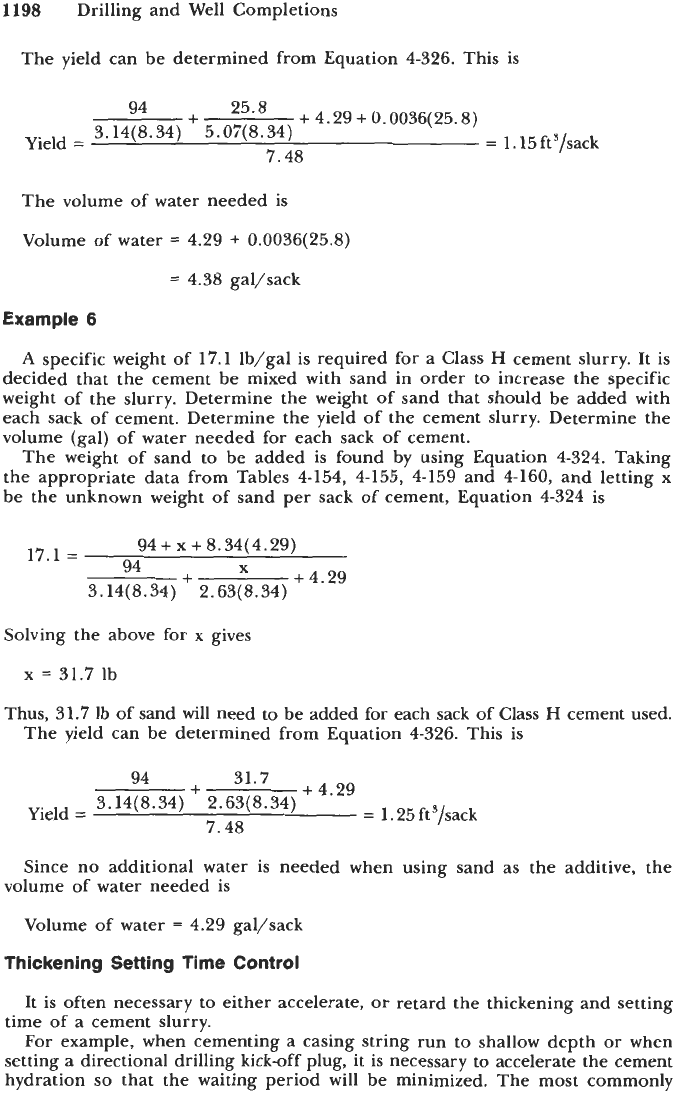
1198
Drilling and Well Completions
The yield can be determined from Equation
4-326.
This is
94
+
25'8
+4.29+0.0036(25.8)
Yield
=
3.14(8.34) 5.07(8.34)
=
1
.15
ft '/sack
7.48
The volume of water needed is
Volume of water
=
4.29
+
0.0036(25.8)
=
4.38
gal/sack
Example
6
A
specific weight of
17.1
lb/gal is required for
a
Class
H
cement slurry. It is
decided that the cement be mixed with sand in order to increase the specific
weight of the slurry. Determine the weight of sand that should be added with
each sack of cement. Determine the yield of the cement slurry. Determine the
volume (gal) of water needed for each sack of cement.
The weight of sand to be added is found by using Equation
4-324.
Taking
the appropriate data from Tables
4-154, 4-155, 4-159
and
4-160,
and letting x
be the unknown weight of sand per sack of cement, Equation
4-324
is
94
+
x
+
8.34( 4.29)
17.1
=
+
4.29
X
94
+
3.14( 8.34) 2.63( 8.34)
Solving the above for x gives
x
=
31.7
Ib
Thus,
31.7
lb of sand will need to be added for each sack of Class
H
cement used.
The yield can be determined from Equation
4-326.
This is
94
+
31*7
+4.29
=
1.25
ft3/sack
3.14(8.34) 2.63( 8.34)
Yield
=
7.48
Since no additional water is needed when using sand as the additive, the
volume of water needed is
Volume of water
=
4.29
gal/sack
Thickening Setting Time
Control
It is often necessary to either accelerate, or retard the thickening and setting
time of a cement slurry.
For example, when cementing a casing string run to shallow depth or when
setting a directional drilling kick-off plug, it is necessary to accelerate the cement
hydration
so
that the waiting period will be minimized. The most commonly
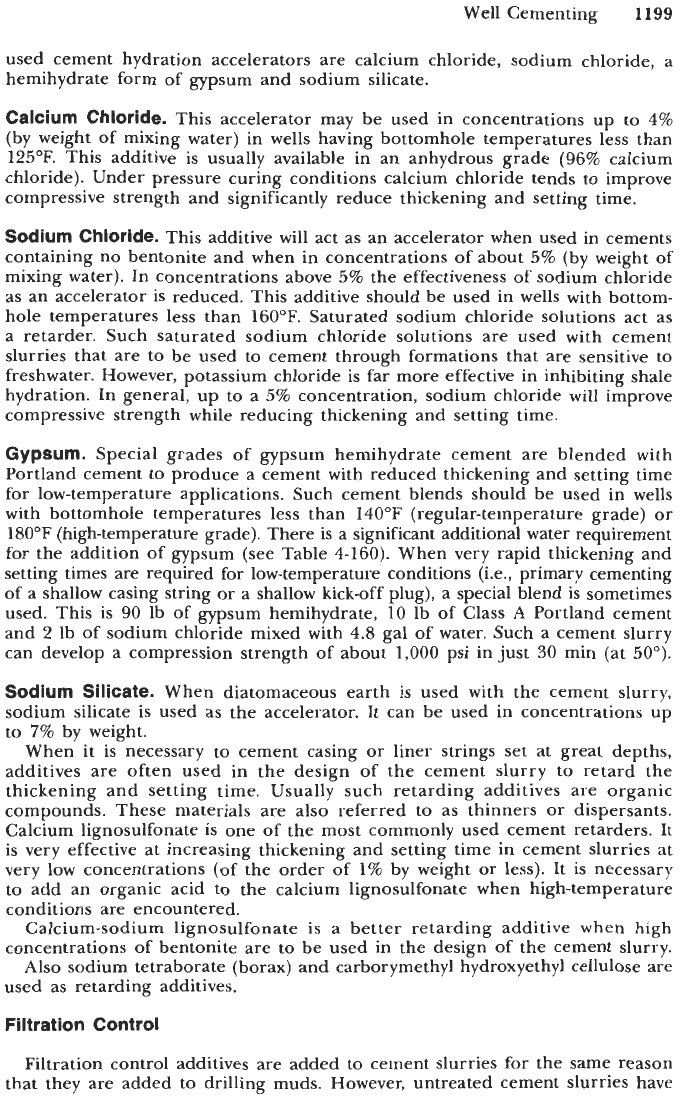
Well Cementing
1199
used cement hydration accelerators are calcium chloride, sodium chloride, a
hemihydrate form of gypsum and sodium silicate.
Calcium Chloride.
This accelerator may be used in concentrations up to
4%
(by weight of mixing water) in wells having bottomhole temperatures less than
125°F.
This additive is usually available in an anhydrous grade
(96%
calcium
chloride). Under pressure curing conditions calcium chloride tends to improve
compressive strength and significantly reduce thickening and setting time.
Sodium Chloride.
This additive will act as an accelerator when used in cements
containing no bentonite and when in concentrations of about
5%
(by weight of
mixing water). In concentrations above
5%
the effectiveness of sodium chloride
as an accelerator is reduced. This additive should be used in wells with bottom-
hole temperatures less than
160°F.
Saturated sodium chloride solutions act as
a retarder. Such saturated sodium chloride solutions are used with cement
slurries that are to be used to cement through formations that are sensitive to
freshwater. However, potassium chloride is far more effective in inhibiting shale
hydration. In general, up to a
5%
concentration, sodium chloride will improve
compressive strength while reducing thickening and setting time.
Gypsum.
Special grades of gypsum hemihydrate cement are blended with
Portland cement to produce a cement with reduced thickening and setting time
for low-temperature applications. Such cement blends should be used in wells
with bottomhole temperatures less than
140°F
(regular-temperature grade) or
180°F
(high-temperature grade). There is a significant additional water requirement
for the addition of gypsum (see Table
4-160).
When very rapid thickening and
setting times are required for low-temperature conditions (i.e., primary cementing
of a shallow casing string or a shallow kick-off plug), a special blend is sometimes
used. This is
90
Ib of gypsum hemihydrate,
10
lb of Class
A
Portland cement
and
2
lb of sodium chloride mixed with
4.8
gal of water. Such a cement slurry
can develop a compression strength of about
1,000
psi in just
30
min (at
50").
Sodium Silicate.
When diatomaceous earth is used with the cement slurry,
sodium silicate is used as the accelerator, It can be used in concentrations up
to
7%
by weight.
When it is necessary to cement casing or liner strings set at great depths,
additives are often used in the design of the cement slurry to retard the
thickening and setting time. Usually such retarding additives are organic
compounds. These materials are also referred to as thinners or dispersants.
Calcium lignosulfonate is one of the most commonly used cement retarders. It
is very effective at increasing thickening and setting time in cement slurries at
very low concentrations (of the order of
1%
by weight or less). It
is
necessary
to add an organic acid to the calcium lignosulfonate when high-temperature
conditions are encountered.
Calcium-sodium lignosulfonate is
a
better retarding additive when
high
concentrations of bentonite are to be used in the design of the cement slurry.
Also sodium tetraborate (borax) and carborymethyl hydroxyethyl cellulose are
used as retarding additives.
Filtration Control
Filtration control additives are added to cement slurries for the same reason
that they are added to drilling muds. However, untreated cement slurries have

1200
Drilling and Well Completions
much greater filtration rates than untreated drilling muds. It is thus important
to limit the loss of water filtrate from a slurry to a permeable formation. This
is necessary for several reasons:
minimize hydration of formations containing water sensitive formations;
limit the increase in slurry viscosity as cement is placed in the well;
prevent annular bridges;
allow for sufficient water to be available for cement hydration.
Examples of filtration control additives are latex, bentonite with a dispersant
and other various organic compounds and polymers.
Viscosity Control
The viscosity of the cement slurry will affect the pumping requirements for
the slurry and frictional pressure gradient within the well. The viscosity must
be kept low enough to ensure that the cement slurry can be pumped to the
well during the entire cementing operation period. High viscosity will result in
high-pressure gradients that could allow formation fractures.
Examples of commonly used viscosity control additives are calcium ligno-
sulfonate, sodium chloride and some long-chain polymers. These additives also
act as accelerators
or
retarders
so
care must be taken in designing the cement
slurry with these materials.
Special Problems Control
additives have been developed. These are
There are some special problems in the design of cement slurries for which
.
Gel strength additives for the preparation of spacers (usually fragile gel
additives)
.
0
Silica flour is used to form a stronger and less permeable cement, especially
for high-temperature applications.
0
Hydrazine is used to control corrosion of the casing.
Radioactive tracers are used to assist in assessing where the cement has
been placed.
Gas-bubble-producing compounds to slowly create gas bubbles in the cement
as the slurry sets and hardens. It is felt that such
a
cement will have less
tendency to leak formation gas.
Paraformaldehyde and sodium chromate that counteract organic contaminants
left in the well from drilling operations.
Fibrous materials such as nylon are added
to
increase strength, in particular,
resistance to impact loads.
Primary Cementing
Primary cementing refers to the cementing of casing and liner strings in a
well. The cementing of casing
or
liner string is carried out
so
that producible
oil and gas,
or
saltwater will not escape from the producing formation to another
formation,
or
pollute freshwater sands at shallower depth.
The running of long casing strings and liner strings to great depths and suc-
cessfully cementing these strings required careful engineering design and planning.

Well Cementing
1201
Normal Single-Stage Casing Cementing
Under good rig operating conditions, casing can be run into the hole at the
rate of from
1,000
to
2,000
ft/hr. It is often necessary to circulate the drilling
mud in the hole prior to running the casing string. This is to assure that all
the cutting and any borehole wall prices have been removed. However, the longer
a borehole remains open, the more problems will occur with the well.
Prior to running the casing string into the well the mill varnish should be
removed from the outer surface of the casing. The removal of the mill varnish
is necessary to ensure that the cement will bond to the steel surface.
The casing string
is
run into the well with a guide shoe on the bottom of
the string. Figures
4-383
and
4-384
show two typical guide shoes. Figure
4-383
is the regular pattern guide shoe that has no drillable internal materials. Figure
4-384
is the swirl guide shoe with drillable aluminum internal materials.
About one
or
two joints above the guide shoe is the float collar. The float
collar acts as a back-flow valve that keeps the heavier cement slurry from flowing
back into the casing string after
it
has been placed in the annulus between the
outside of the casing and the borehole wall. Figures
4-385
and
4-386
show two
typical float collars. Figure
4-385
is a ball float collar and Figure
4-386
is a
flapper float collar. Both float collars are constructed with drillable aluminum
internal parts (larger float collars have a combination of cement and aluminum
internal parts).
Along the length of the casing string are placed scratchers and centralizers.
Figure
4-387
shows the typical scratcher. Figure
4-388
shows the typical
centralizer. The scratchers help remove the mud cake as the casing string is
lowered into the well. The centralizers ensure that the casing is nearly centered
in the borehole, thus allowing
a
more uniform distribution of cement slurry
flow around the casing. This nearly uniform flow around the casing is necessary
to remove the drilling mud in the annulus.
The casing string is lowered into the drilling mud in the well using the rig
drawworks and elevators. The displaced drilling mud flows to the mud tanks
Figure
4-383.
Regular pattern guide shoe
[161].
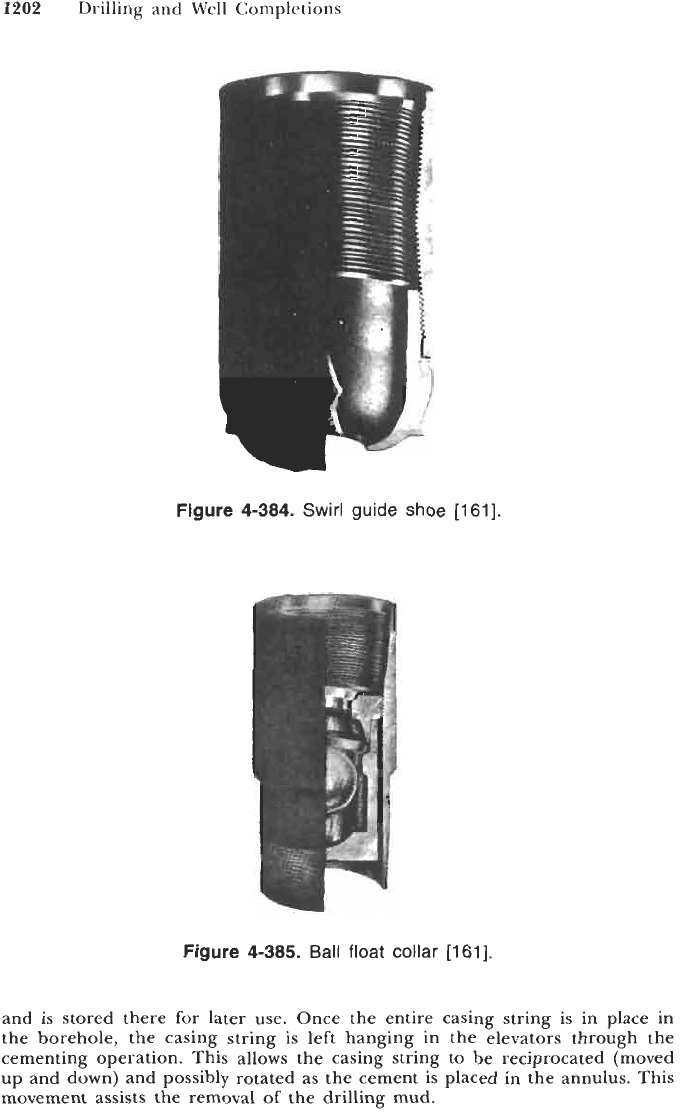
1202
Drilling and Well Completions
Figure 4-384.
Swirl
guide
shoe
[161].
Figure
4-385.
Ball
float
collar
[161].
and is stored there for later use. Once the entire casing string is in place in
the borehole, the casing string is left hanging in the elevators through the
cementing operation. This allows the casing string
to
be reciprocated (moved
up and down) and possibly rotated as the cement is placed in the annulus. This
movement assists the removal
of
the drilling mud.

Well Cementing
1203
Figure
4-386. Flapper float collar
[161].
Reciprocating
'/
\\
Scratchers
Figure
4-387.
Scratcher
[161].
While the casing string is hanging in the elevators a cementing head is made
up to the upper end of the string (see Figure 4-381). The cementing head is
then connected with flow liners that come from pump truck (see Figure 4-380).
The blender mixes the dry cement and additives with water. The high-pressure,
low-volume triplex cement pump on the pump truck pumps the cement slurry
to the cementing head. Usually a preflush
or
spacer is initially pumped ahead
of the cement slurry. This spacer (usually about 15 to 25 bbl) is used to assist
in removing the drilling mud from the annular space between the outside
of
the casing and the borehole wall.
Figure 4389 gives a series
of
schematics that show how the spacer and cement
slurry displace drilling mud in the well. Two wiper plugs are usually used to
~
separate the spacer and the cement slurry from the drilling mud in the well.
The cementing head has two retainer valves that hold the two flexible rubber
wiper plugs with two separate plug-release pins (see Figure 4-389a). When the
spacer and the cement slurry are to be pumped to the inside of the casing
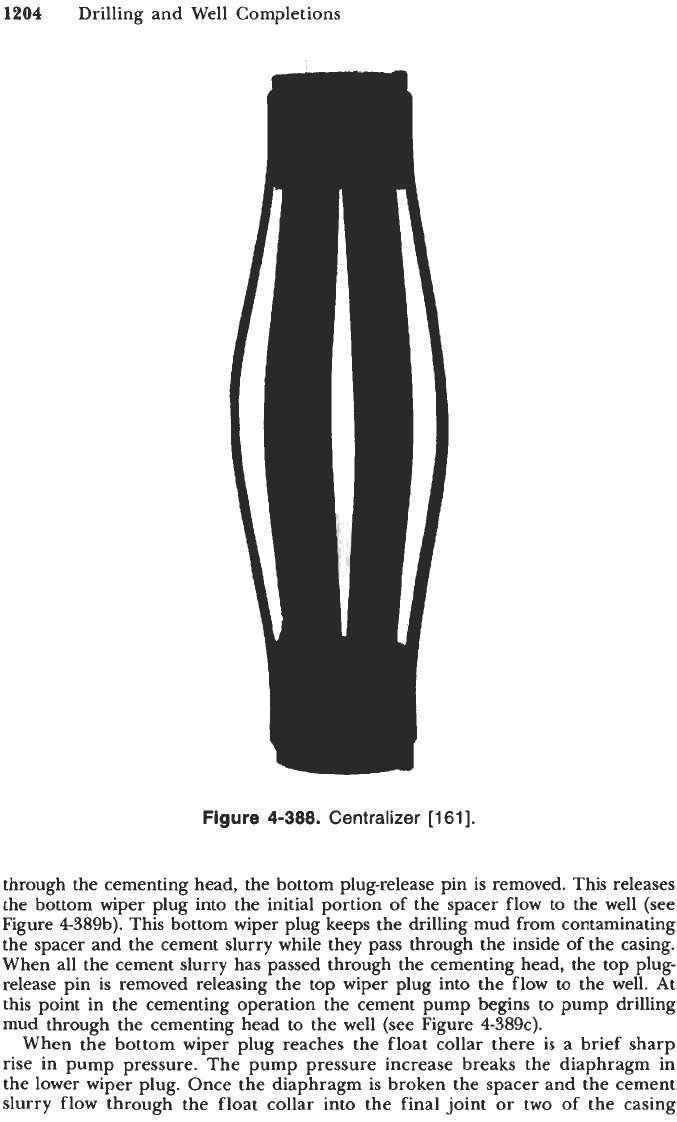
1204
Drilling and Well Completions
Figure
4-388.
Centralizer
[161].
through the cementing head, the bottom plug-release pin is removed. This releases
the bottom wiper plug into the initial portion of the spacer flow to the well (see
Figure 438913). This bottom wiper plug keeps the drilling mud from contaminating
the spacer and the cement slurry while they pass through the inside of the casing.
When all the cement slurry has passed through the cementing head, the top plug-
release pin is removed releasing the top wiper plug into the flow to the well. At
this point in the cementing operation the cement pump begins to pump drilling
mud through the cementing head to the well (see Figure 4389c).
When the bottom wiper plug reaches the float collar there is a brief sharp
rise in pump pressure. The pump pressure increase breaks the diaphragm in
the lower wiper plug. Once the diaphragm is broken the spacer and the cement
slurry flow through the float collar into the final joint
or
two of the casing
